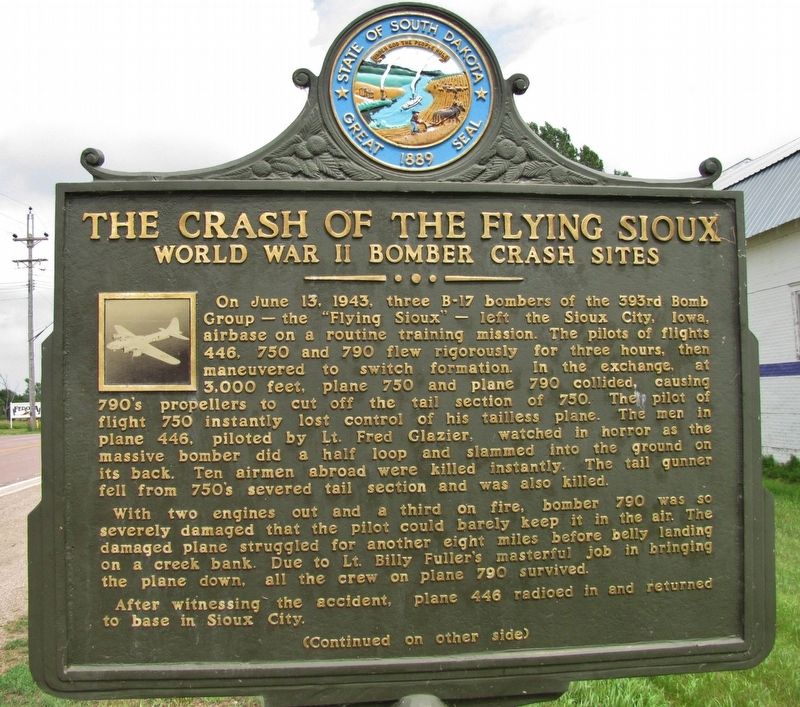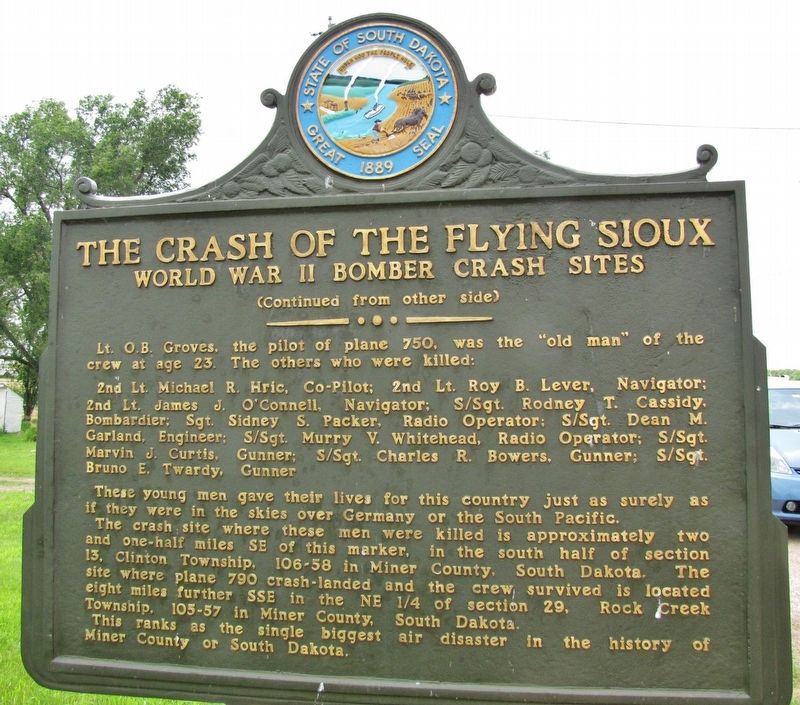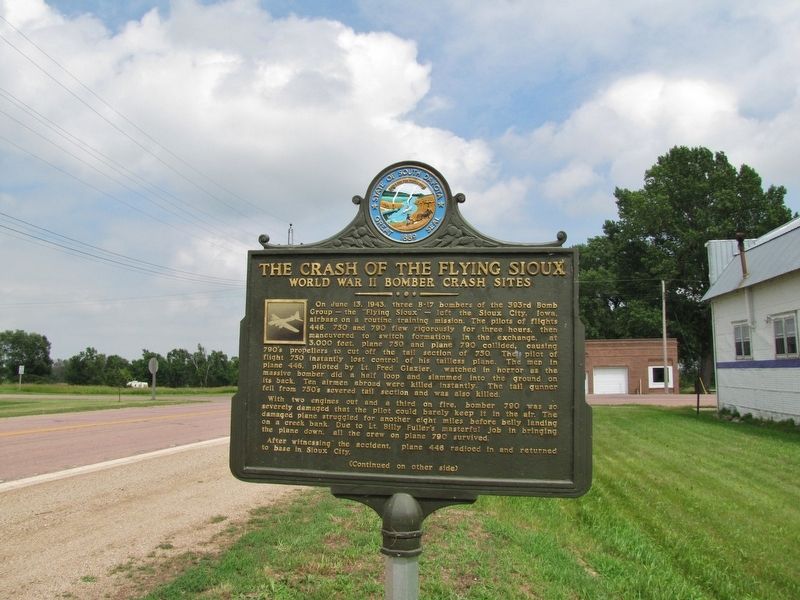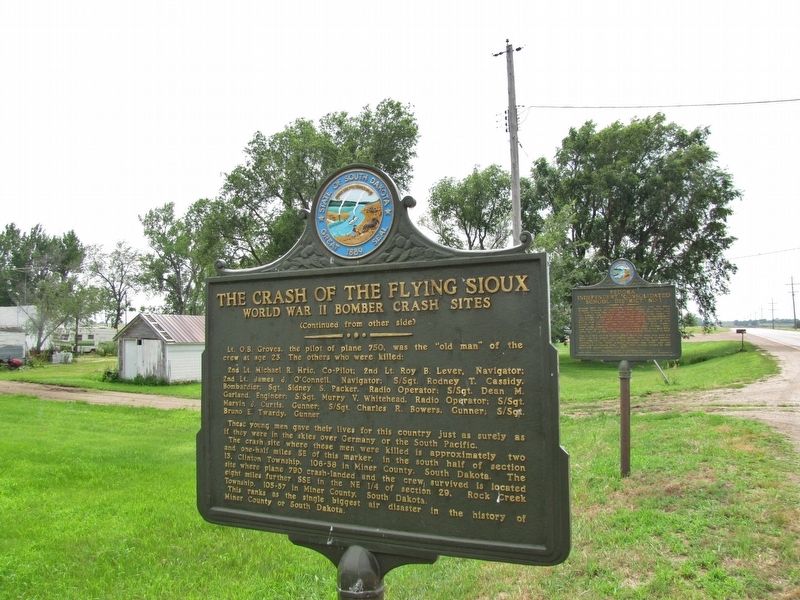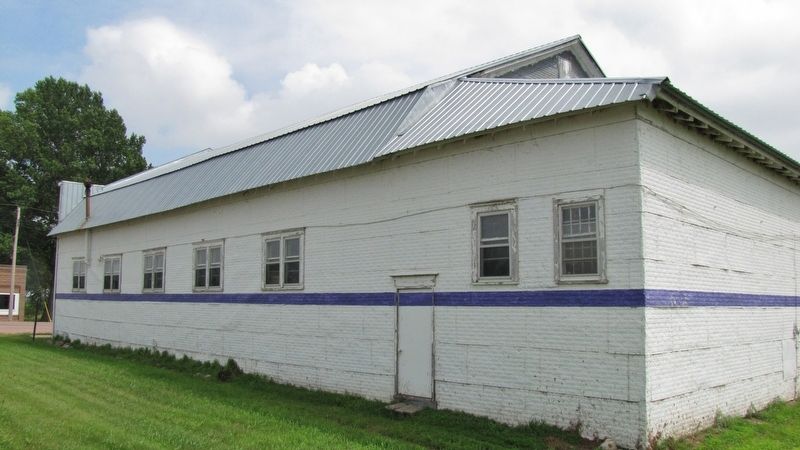Fedora in Miner County, South Dakota — The American Midwest (Upper Plains)
The Crash of the Flying Sioux
World War II Bomber Crash Sites
(side 1)
On June 13, 1943, three B-17 bombers of the 393rd Bomb Group — the “Flying Sioux” — left the Sioux City, Iowa, airbase on a routine training mission. The pilots of flights 446, 750 and 790 flew rigorously for three hours, then maneuvered to switch formation. In the exchange, at 3,000 feet, plane 750 and plane 790 collided, causing 790's propellers to cut off the tall section of 750. The pilot of flight 750 instantly lost control of his tailless plane. The men in plane 446, piloted by Lt. Fred Glazier, watched in horror as the massive bomber did a half loop and slammed into the ground on its back. Ten airmen abroad were killed instantly. The tail gunner fell from 750's severed tail section and was also killed.
With two engines out and a third on fire, bomber 790 was so severely damaged that the pilot could barely keep it in the air. The damaged plane struggled for another eight miles before belly landing on a creek bank. Due to Lt. Billy Fuller's masterful job in bringing the plane down, all the crew on plane 790 survived.
After witnessing the accident, plane 446 radioed in and returned to base in Sioux City.
(side 2)
Lt. O.B. Groves, the pilot of plane 750, was the “old man” of the crew at age 23. The others who were killed:
2nd Lt. Michael R. Hric, Co-Pilot; 2nd Lt. Roy B. Lever, Navigator; 2nd Lt. James J. O'Connell, Navigator; S/Sgt. Rodney T. Cassidy, Bombardier; Sgt. Sidney S. Packer, Radio Operator; S/Sgt. Dean M. Garland, Engineer; S/Sgt. Murry V. Whitehead, Radio Operator; Marvin J. Curtis, Gunner; S/Sgt. Charles R, Bowers, Gunner; S/Sqt. Bruno E. Twardy, Gunner.
These young men gave their lives for this country just as surely as if they were in the skies over Germany or the South Pacific.
The crash site where these men were killed is approximately two and one-half miles SE of this marker, in the south half of section 13, Clinton Township, 106-58 in Miner County, South Dakota. The site where plane 790 crash-landed and the crew survived is located eight miles further SSE in the NE 1/4 of section 29, Rock Creek Township, 105-57 in Miner County, South Dakota.
This ranks as the single biggest air disaster in the history of Miner County or South Dakota.
Erected 2008.
Topics. This memorial is listed in these topic lists: Air & Space • Disasters • Notable Events • War, World II. A significant historical date for this entry is June 13, 1943.
Location. 44° 0.532′ N, 97° 47.495′ W. Marker is in Fedora, South Dakota, in Miner County. Memorial is on 233rd Street (State Highway 34) west of 421st Avenue, on the right when traveling east. Marker is located on the south side of the highway, near the northeast corner of the Fedora Community Hall building. Touch for map. Marker is in this post office area: Fedora SD 57337, United States of America. Touch for directions.
Other nearby markers. At least 3 other markers are within 13 miles of this marker, measured as the crow flies. Fedora Independent Consolidated School District No. 1 (here, next to this marker); In Memorium (approx. 6½ miles away); Town of Epiphany (approx. 12.6 miles away).
Also see . . . WWII airmen honored 65 years after crash. Even 65 years after his B-17 bomber collided with another near Fedora, Lawrence Dreesen still finds his mind drifting back to the midair collision that killed 11 young airmen. Dreesen was a guest of honor at a ceremony Friday to dedicate a roadside historical marker that commemorates the training accident that occurred nearby in 1943. On a training mission, two B-17 bombers collided, killing all 11 members of one plane and causing the other plane and its crew -- including Dreesen, then a 23-year-old radio operator -- to crash land eight miles southeast of Fedora. (Submitted on October 12, 2018, by Cosmos Mariner of Cape Canaveral, Florida.)
Credits. This page was last revised on October 14, 2018. It was originally submitted on October 11, 2018, by Cosmos Mariner of Cape Canaveral, Florida. This page has been viewed 793 times since then and 124 times this year. Photos: 1, 2, 3, 4, 5. submitted on October 12, 2018, by Cosmos Mariner of Cape Canaveral, Florida. • Andrew Ruppenstein was the editor who published this page.
